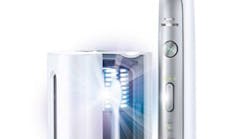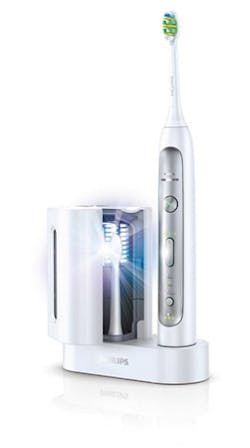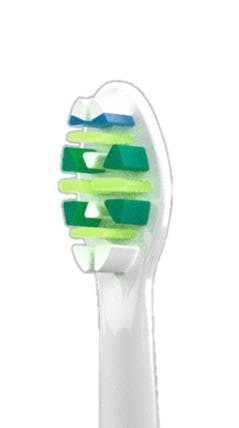In 2013, Philips Sonicare introduced its latest model of the sonic power toothbrush. The Philips Sonicare FlexCare Platinum power toothbrush has several features that can assist patients in effectively removing plaque biofilm on the smooth and interproximal surfaces. Thorough interproximal biofilm removal will still be needed with dental floss or other interdental cleaning products but the brush greatly enhances overall biofilm removal by the patient.
Following are some of the features available with this new brush:
• The brush comes with the new InterCare brush head that has longer bristles for enhanced interproximal cleaning.
• Philips Sonicare FlexCare Platinum power toothbrush is a pressure sensor built into the handle (no external components) that gently resonates to alert the patient when too much pressure is applied.
• The brush features the Quadpacer and Smartimer to assist patients in brushing longer and completely.
• When fully charged, the battery lasts for 3 weeks. In addition, the brush comes with a travel case making it easy to pack.
• The brush has 3 settings (Clean, White and Gum Care) and 3 intensity levels (Low, Medium and High). This combination allows the patient to customize 9 different modes of operation including adjusting the settings for patients who have sensitivity issues. In addition, the settings can be changed or adjusted while the patient is brushing.
• The InterCare brushhead is designed with both long and short bristles such that the longer bristles provide enhanced interproximal biofilm removal while the shorter bristles remove biofilm along the gingival margin. When the brush head needs to be replaced, the bristles fade in color.
• Finally, the brush is available with or without the brush head sanitizer.
Now more than ever, patients have great choices in products to assist them in meeting their oral hygiene goals. Every dental hygienist should become familiar with the products available to patients so that they are ready to recommend the best product for their patients’ oral health needs.
References
1. Socransky SS, Haffajee AD, Cugini MA, et al. Microbial complexes in subgingival plaque. J Clin Periodontol. 1998; 25:134-144.
2. Barnes CM, Gluck JI, Lyle DM, Jahn CA. Devices for oral self-care. In: Daniel S, Harfst S, Wilder R, eds. Mosby’s Dental Hygiene: Concepts, Cases and Competencies. Second Edition. St. Louis: Elsevier, 2008. pps. 448-454.
3. Raposa KA, Ray TS. Oral infection control: Toothbrushes and toothbrushing. In Wilkins E., eds. Clinical Practice of the Dental Hygienist. Tenth Edition. Philadelphia: Lippincott Williams & Wilkins, 2009. pps. 418-419.
4. Sharma NC, Qaqish JG, He T, Walters PA, Grender JM, Biesbrock AR. Plaque and gingivitis reduction efficacy of an advanced pulsonic toothbrush: a 4-week randomized and controlled clinical trial. Am J Dent. 2010 Dec; 23(6):305-10.











